Diving Planes for
Erie 'Eyes
by Mark Hicks
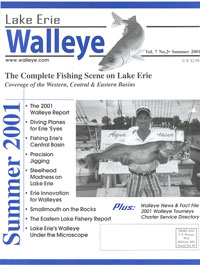
Order Lake Erie Walleye Magazine
Three Information-Packed Issues for only $10.00
Delivered to your doorstep every March, June and September
|
Diving Planes for
Erie 'Eyes |
|
C
aptain Bob Troxel’s first experience with diving planes illustrates why these trolling devices should be mainstays for every Lake Erie walleye angler. The outing took place on a hot July afternoon several years ago.Drift fishing with weight-forward spinners had slumped badly
after the peak early summer season. 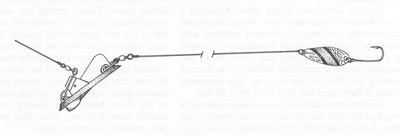 Faced
with markedly clearer water due to the zebra mussel invasion, Troxel conceded
that he would have to adopt trolling methods to catch boat-shy walleyes in deep
water.
Faced
with markedly clearer water due to the zebra mussel invasion, Troxel conceded
that he would have to adopt trolling methods to catch boat-shy walleyes in deep
water.
Heading his 30-foot cruiser, "This Is Reality," out from Foxhaven Marina on Catawba Island, Troxel and two friends boated west of Rattlesnake Island in the western basin. When the graph began marking fish near the bottom in 32 feet of water, they put out four brand new diving planes matched with spoons fresh out of their colorful packages.
"I really didn’t know what to expect," says Troxel. "But I didn’t have much time to think about it. In two hours we landed three limits of big walleyes, including one over 11 pounds. It was unbelievable."
The relatively low cost of diving planes, plus the fact that other anglers were enjoying excellent results with them, figured into Troxel’s decision to try this method of trolling. He still relies on the same brand of diver he started with-Luhr Jensen’s Dipsy Diver.
ESSENTIAL DIVERS
Available in three sizes that run at depths ranging from 14 to more than 50
feet, the Dipsy Diver is built around a hard plastic disk. The larger two sizes
come with an "O" ring that expands their diameters and increases their
running depths. These models also 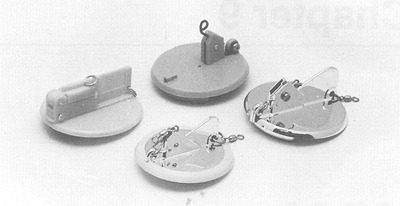 feature
an adjustable release mechanism that attaches to the rod line. Snap the release
in place and the Dipsy digs powerfully downward. When the release breaks free,
the Dipsy flattens and stops diving, eliminating its strong resistance.
feature
an adjustable release mechanism that attaches to the rod line. Snap the release
in place and the Dipsy digs powerfully downward. When the release breaks free,
the Dipsy flattens and stops diving, eliminating its strong resistance.
What makes the Dipsy so versatile is its directional feature. On a 0 setting, the diver runs true. But when an underside weight is adjusted to the right or left of center on specific settings from I to 3, the diver angles to the left or right side of the boat. The higher the setting, the farther the diver swings out.
Using different settings spreads the lines, which prevents tangles and increases the width of the trolling swath. Some charter captains set out as many as eight divers at a time. The center divers run deepest, while those set to sweep farthest away from the boat run shallowest.
Another directional diving plane, Kastaway’s Diver, features a magnetic release. Should the release inadvertently pop free-a common problem with these types of divers-simply drop the rod tip sharply to put a little slack in the line. This allows the magnetic release to reset itself and averts the chore of winding the diver all the way up. The Kastaway comes in three sizes that dive from 50 to 80 feet
Leaders on most divers must not exceed the rod’s length so that fish may be reeled close enough to net them. A short leader helps when trolling spoons, since it gives them a snappier action. Long minnow crankbaits and other lures, however, may trigger more strikes when trolled on longer leaders.
The directional Slide Diver, from U-Charters Inc., overcomes this dilemma. The rod line feeds through the Slide Diver’s release mechanism, so you may set the lure back as far as you wish from the diver. When a walleye strikes, the release opens and the diver slides down the line to the fish. Randy Even, who designed the Slide Diver, recommends using an abrasion resistant line, such as 20-pound Berkley XT.
Diving planes are typically set back from the boat 75 to 180 feet. Most divers come with charts that indicate how deep they run at different settings. With 125 feet of line out, for example, the standard Kastaway Diver reaches 55 feet at the 1 (center) setting, 48 feet at the 3 setting and 42 feet at the 5 setting. The actual depths vary depending on the type of line used, trolling speed, influence of under- water currents and other factors.
Most divers come in a variety of colors that may help attract walleyes. Precut reflective tape panels also may be purchased for Dipsy Divers.
DIVER TACKLE
"The bigger disk divers pull hard," says Capt. Troxel. "They require rod holders and stout rods."
Several manufactures offer rods specifically de- signed for diving planes. They generally run from about 7 to more than 10 feet in length and boast strong butt sections with limber tips. Troxel has settled on an 8 1/2-foot model made by Daiwa.
"You need that soft tip," he says, "so you can see the rod
rattle when a fish hits. A small fish may 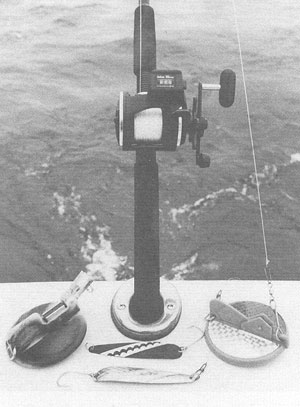 not
snap the release. If you don’t see the strike, you may drag it for quite a
while. You have to watch your rods closely and check them regularly."
not
snap the release. If you don’t see the strike, you may drag it for quite a
while. You have to watch your rods closely and check them regularly."
Light, big-water trolling reels with low gear ratios ease the task of dredging up diving planes. Fill reels with line that withstands the relentless drag of a diving plane. Troxel started out with 20-pound monofilament. Though it served well, he switched to one of the new super-strong braided lines, as have many other anglers who dote on diving planes.
A 25-pound super braid has the diameter of 6- to 8-pound monofilament, so it lets divers run deeper. Because this type of line has virtually no stretch, rods respond more vigorously to strikes, and the releases on the divers break cleanlier. Avoid Dacron braided lines, however, since they prevent divers from reaching maximum depths.
These days, Troxel runs Berkley FireLine. It handles more like monofilament, but retains the virtues of the super braids. However, he still runs a clear, 20-pound monofilament leader to his lure, which he believes is less visible to walleyes.
"A heavy leader doesn’t seem to affect the bite," he says, "and I’ve never snapped a fish off with one."
Many anglers use snubbers when trolling diving planes. Typically a 6-inch length of rubber tubing, a snubber acts as shock absorber between the rod line and the diver. It prevents a sudden jolt, such as bumping bottom or a hard strike from a big fish, from breaking off the diver or the lure. Snubbers are especially important when using lighter leaders.
BASIC SETUPS
Since he trolls primarily in the shallower western basin, Troxel doesn’t have to get his divers as deep as anglers do in the central and eastern basins. He relies on his Bottom Line LCG to determine how deep the walleyes are holding and then runs his divers at that depth or slightly above it.
His two outside rods drag No. I Dipsy Divers, on a 3 setting, which pulls
them well away from the boat. 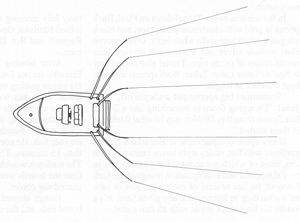 He
lets out only enough line to reach the fish he sees suspended on his LCG. The
two center rods pull No. 0 Dipsy Divers, the second largest size. He sets them
back about 200 feet to intercept fish that may have been bothered by his boat
passing overhead. The larger No. I Dipsy would plow bottom if set that far back
in the 40-foot and shallower water that Troxel normally fishes.
He
lets out only enough line to reach the fish he sees suspended on his LCG. The
two center rods pull No. 0 Dipsy Divers, the second largest size. He sets them
back about 200 feet to intercept fish that may have been bothered by his boat
passing overhead. The larger No. I Dipsy would plow bottom if set that far back
in the 40-foot and shallower water that Troxel normally fishes.
In the central and eastern basins, where walleyes regularly swim 55 feet or deeper, the largest directional divers rule. Capt. Andy Emrisko, who docks his 27-foot Wave Walker at Cleveland’s Lakefront State Park, usually sets out six No. I Dipsy Divers.
To help separate the divers, Emrisko employs three braces of rods in different lengths that rest in three pairs of holders. The two holders on each comer of the transom support 8-foot rods matched with divers set on a 0 or I setting. The next pair of holders on the gunnels receive 9-foot rods with Dipsy Divers adjusted to a 2 or 2 1/2 setting. A little farther up the gunnels, a third pair of holders carry 10-foot rods connected to divers adjusted to a 3 or 3 1/2 setting. Each rod reaches farther out than the next, and each Dipsy swims farther out to the side than the next.
"The more line you let out," says Ennisko, "the deeper a Dipsy
goes. But once you get much past 150 feet,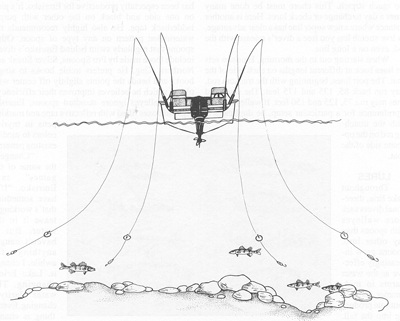 you hit a neutral point where it goes no deeper. "Even so, I may run it
back 200 feet to get my lure farther away from my boat noise."
you hit a neutral point where it goes no deeper. "Even so, I may run it
back 200 feet to get my lure farther away from my boat noise."
When trolling a diver on 200 feet of monofilament, it is extremely difficult to pop the release by sweeping the rod back. Monofilament has too much stretch. This chore must be done many times a day to change or check lures. Here is another instance where a new super line has a clear advantage. Its low stretch lets you free a diver’s release with the rod, even on a long line.
When starting out in the morning, Emrisko sets his lines back at different lengths on each side of the boat. The port lines, beginning with the transom rod, may run back 85, 135 and 175 feet. The starboard lines may run 75, 125 and 150 feet. If walleyes show a preference for a particular setup,- he duplicates it with the matching rod on the opposite side of the boat.
LURES
Throughout Lake Erie, directional divers sack more walleyes with
spoons than any other lure. Spoons grow increasingly effective as the water warms in mid- summer, and they continue producing into the fall.Combine active walleyes with flashing spoons and you’ve got the makings for
a heavy catch. In the western basin, Troxel dotes on Flash Back Spoons in gold
with chartreuse prism tape, and black with green prism tape and a white belly.
Other proven colors 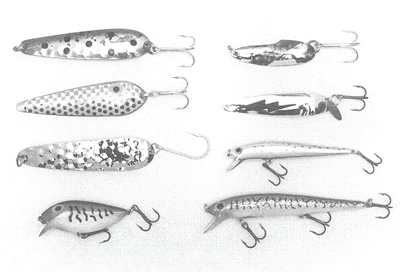 include
silver and white, each dressed with various colors of prism tape. Troxel also
favors Bay De Noc’s Flutter Laker Taker. Both spoons measure about 4 inches in
length.
include
silver and white, each dressed with various colors of prism tape. Troxel also
favors Bay De Noc’s Flutter Laker Taker. Both spoons measure about 4 inches in
length.
"Sometimes big spoons put walleyes off," says Troxel. "Dropping down to something like a 2-inch Flute Spoon from Bay De Noc may be what it takes to get them started."
Every spare compartment in Emrisko’s cruiser overflows with flat, utility style boxes crammed with lures, most of which are spoons. He owns spoons in every size, color and configuration imaginable. And, of course, he has several of each type, just in case that’s what they’re hitting on at any given time. It’s a wonder his boat stays afloat with all that metal.
A 3 3/8-inch Pentwater Spoon in the 501 pattern has been especially productive for Emrisko. It’s pink on one side and black on the other with purple ladderback tape. He also highly recommends the watermelon pattern on any type of spoon. Other spoons that regularly swim behind Emrisko’s divers include those made by Pro Spoons, Silver Streak and Northern King. He prefers treble hooks to single hooks and bends the points slightly off center with pliers, which he believes improves their efficiency.
If walleyes ignore standard spoons, Emrisko digs out boxes filled with reflective tape and marking
pens in myriad colors to modify existing patterns."Change is the name of the game, says Emrisko. "If I have something that’s working, I leave it in the water. But if haven’t caught anything for awhile, I change it. Lake Erie’s changing. The water clarity’s changing. Everything is changing. You’ve got to change your baits too."
Changes were unnecessary during a hazy July morning aboard the Wave Walker when I joined Emrisko, George McKenzie, Mike Shott, Art Regnelli and Bob Daniel, all northeast Ohio fishermen.
After boating 13 miles north of Cleveland, Emrisko set out four diver rods rigged with spoons. He began putting out boards that would carry additional lines, but was interrupted when a 6-pound walleye slammed a spoon on one of the divers.
After netting the fish, Emrisko went back to work on the boards, but had to stop again to net another fish. He normally sets out board lines in less than 15 minutes. That morning it took him an hour. The walleyes wouldn’t leave the spoons alone. By the time the boards were finally set, 10 respectable fish graced our cooler.
Things slowed somewhat after that, with the board rods and the diver rods both taking additional fish. When the sun burned off the haze and the breeze died early in the afternoon, the action slowed considerably. "It’s always tough when the lake gets flat," said Emrisko.
He responded by changing spoons in earnest. When he finally found a pattern that worked-a silver spoon dressed with green ladderback tape-he switched several other rods over to the same combination and managed to fill our limits.
Though spoons account for most of Emrisko’s walleyes on divers, he has success with other lures. Capt. Ron Johnson, who makes a habit of winning major walleye tournaments out of Fairport Harbor with diving planes, has added crawler harnesses to the lures he carries aboard his boat, "Thumper."
"The water clarity is unreal," he says. "My techniques have changed. You want to attract the fish, but if you put out too much flash you’ll spook them." Johnson reduces flash when running crawler harnesses by cutting back to one blade. Some of his harnesses sport two treble hooks, which he rigs with three crawlers so they all hang straight. It’s a virtual smorgasbord for walleyes.
"When I run spinners," he says, "I troll at about 1.4 to 1.5 miles per hour.
"The problem with crawler harnesses is that they attract a lot of attention from sheephead and other undesirable fish. They pick the bait off your lures, and you may be dragging a small fish without knowing it. That wastes a lot of time."
When walleyes grow aggressive enough to nail spoons, Johnson feeds them hardware. He trolls at a faster clip with spoons, usually from about 2 to 2.4 m.p.h. Emrisko prefers an even faster pace with spoons, from 2.5 to 2.9 m.p.h. He feels that covering more territory pays off better than a slower trolling speed.
Water temperature helps Capt. Pete Alex determine when to get serious with divers. He heads out on Lake Erie’s central basin in his Vision Quest charter boat from Erie Angler Marina in Erie, Pennsylvania.
"You don’t have to see them on your graph to catch them," says Alex. "When the water temperature gets up around 70 degrees, some walleyes drop down to the 35- to 40-foot range. That’s when I start catching more fish with divers."
Shallow running minnow imitators perform well with divers for Alex. He especially likes Storm’s ThunderStick, Jr., ThunderStick, and Rattlin’ Thin Fin. Early in the morning and on dark days, he goes with purple or green patterns. Firetiger is a proven producer. On sunny days he runs metallic colored lures behind his divers, such as metallic rainbow trout, black/silver and blue/silver.
In the eastern basin, Ted Malota, also acclaimed for his skill with diving planes, runs a variety of lures. This Hamburg, New York, resident frequently teams up with Capt. Bill King who runs his Searcher One out of Chadwick Bay Marina in Dunkirk Harbor,
New York. The water clarity in the deep eastern basin exceeds that found anywhere else in Lake Erie, which presents special challenges.
"We’ve used Dipsy Divers over the past 8 years," says Malota. "We’ve gotten into finer stuff because of the water clarity caused by the zebra mussels."
One adjustment includes moving up to 10 1/2- foot diver rods that accommodate longer 10-foot leaders made from 10-pound Trilene XT. Malota believes longer, thinner leaders coax strikes from walleyes that may shy from divers sporting shorter leaders. He is also convinced that longer leaders allow the spoons to work with a more alluring action when the boat snakes back and forth in "S" turns.
"If you’re making "S" turns," says Malota, "the outside diver runs faster. The inside one slows. They’re rising and falling like pistons. That’s where the majority of our strikes come from."
Lately, worm harness have been working well for Malota and King, particularly a little number flaunting a pink and white willow leaf blade with a silver back ahead of a string of red and white beads.
In midsummer, when the smelt run small, the big hitter for Malota and King is a 2-inch C5 Northern King spoon in black and pink with a silver back. Copper with orange is also ‘good. Later in the season, larger spoons get the call, such as Northern King’s 28, and Luhr Jensen’s Flutter Spoon in silver and blue.
"We tip all our spoons," says Malota, "with a piece of a crawler just over an inch long. We hook it right through the head so it doesn’t effect the spoon’s action."
GETTING DEEPER WITH DIVING PLANES
Walleyes in the central and eastern basins often drop below the normal running depths of most diving disks. One way to get divers deeper is by adding weight. With a Dipsy Diver, attach a bead chain sinker between the release and the rod line.
Kastaway’s Diver features an eye on its integral bottom weight where you may fasten an additional weight with a snap swivel. The manufacturer, Kulis, Inc., claims that each ounce of extra weight increases the diving depth by about 5 feet.
Wire line affords another option, though it does groove rod guides. Malota claims that his Dipsy Divers have hit bottom 65 feet deep when trolled with wire. The wire line guru in the central basin, Art Lyon of Conneaut, Ohio, relies on 20-pound, single strand Williams or American brand wire for trolling divers.
"They go deeper with wire," says Lyon, "and you get real snappy releases. The rods are a lot more sensitive, too. Wire weakens if you get a kink in it, but guys who use it regularly don’t have too much trouble."
OTHER DIVING PLANES
While directional disks comprise the most versatile diving planes, non-directional divers afford other options. Luhr Jensen’s Jet Diver, which floats at rest, rates high with Lake Erie anglers. It’s available in five sizes that dive from 10 to 50 feet deep in 10-foot increments.
The smaller Jet Divers see the most play on Lake Erie when used in conjunction with trolling boards.
Luhr Jensen’s Deep Six features a trip action release and comes in three sizes that dive to 40, 60 and 90 feet respectively. The company’s Pink Lady, billed as the original diving sinker, has a slide bar that eliminates the diving angle when a fish strikes.
The Fish Seeker, from Fish Seeker, dives to depths of 70 feet. When a walleye strikes, it flips over and surfaces.
Only two non-direction divers should be run at any given time, and they should be trolled from opposite corners of the transom to avoid tangling.
This article by Mark Hicks is a reprint (Chapter 9) from Mark's book, "Lake Erie Walleye". His book can be ordered by calling
1-800-447-8238.